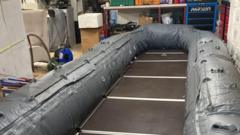
Investing Environment Investors went into Q3 waiting for an all-clear sign on inflation that would let the Fed finally cut interest rates. Economic data during the period pointed in that direction, with soft readings on employment and inflation. Consumer price index (CPI) data generally trended lower over the quarter, with the most recent August core CPI reading showing a 3.
2% year-over-year increase, the lowest since 2021. Meanwhile, non-farm payrolls rose by just 114,000 jobs in July, well below the consensus expectation of 175,000, and the unemployment rate rose to 4.3%.
The jobs report sparked fears that the Fed may have waited too long to cut interest rates and risked damaging the economy. Fed Chair Jerome Powell used his Jackson Hole speech to signal an interest rate cut in September, and the Federal Open Market Committee followed through with a 50bps cut. Elsewhere, the Bank of England and the European Central Bank also cut rates by 25bps in the quarter.
In contrast, the Bank of Japan surprised the market by raising rates, resulting in a stronger yen and triggering an unwinding of a popular US dollar-Japanese yen carry trade, which caused a short-lived spike in volatility. Markets experienced a style and sector performance rotation in Q3. Looking at the Russell 1000® Index, performance in the first half of the year was dominated by a narrow set of US mega-cap winners (the Magnificent Seven).
This narrow leadership meant growth outperformed value, large caps outperformed small caps, and sector performance was led by information technology and communication services. Results in Q3 were the opposite: value outperformed growth, small caps outperformed large caps, and previously shunned sectors, such as utilities and real estate, gained renewed favor with investors. Although US markets were robust, non-US markets also saw gains, most notably emerging markets.
Late in the quarter, the People's Bank of China announced a major stimulus package that led to one of the sharpest and most concentrated rallies in Chinese market history, as investors hoped the measures would reinvigorate the world's second-largest economy. Performance Discussion Our portfolio outperformed the Russell 2000® Growth Index in Q3. Outperformance was driven by positive security selection within two of our power alleys, health care and consumer discretionary, both of which benefited from one of our better earnings seasons in recent history.
Offsetting positive security selection was an allocation headwind due to our overweight to information technology and underweight to financials. Small caps experienced strength in the quarter, especially in July, when the Russell 2000® Index's return was 10.2%.
This was only the 19th time since the creation of the index in 1984 when a month returned over 10%. The Russell 2000® Index outperformed the Russell 1000® Index by 320bps in the quarter. Among our top Q3 contributors were Guidewire ( GWRE ), Veracyte ( VCYT ) and SharkNinja ( SN ).
Guidewire is a market leader in next-generation property and casualty (P&C) insurance software. The company's software enhances modern underwriting and claims operations by supporting workflows, external collaboration and rule-based decision-making. It recently transitioned from a licensed software business model to a subscription-based cloud service.
We have seen these cloud subscription transitions before-they involve sacrificing near-term profitability for higher and more predictable long-term cash flows. As companies emerge from these (often messy) transitions, their profit growth tends to accelerate. We believe Guidewire is at this inflection point.
In an environment that generally has been challenging for software, the company posted strong earnings results, including annual recurring revenue growth of 14% and the signing of 16 new cloud deals. After struggling in the early part of this year, Veracyte shares have rebounded in recent months. The company specializes in improving diagnostic accuracy by combining RNA sequencing, machine learning and the company's proprietary "field of injury" technology.
We believe Veracyte has the potential to build an annuity-like revenue stream in health care. The company is harvesting profits from its existing products and investing in new genetic tests to detect diseases, including prostate and thyroid cancer. We believe its new tests could reduce the number of surgeries performed on patients with indeterminate results from other types of testing and save the health care system unnecessary overtreatment costs.
Shares rallied after the company reported strong earnings results, including 23% growth in test volumes, 27% revenue growth and 21% EBITDA margins. SharkNinja is a leading household consumer products company. Its Shark brand focuses on the cleaning category (vacuums, mops, carpet cleaners, etc.
) and, more recently, beauty (hair dryers, hair stylers, etc.). Its Ninja brand focuses on food preparation (blenders, food processors, ice cream makers, juicers, etc.
) and cooking (indoor grills, ovens, toasters, cookers, air fryers, etc.). We believe a healthy combination of market share gains within existing categories, new category entries and international expansion will drive growth.
Shares rallied after reporting strong earnings results, including 31% revenue growth and 600bps of gross margin expansion. Among our top detractors were iRhythm ( IRTC ), e.l.
f. Beauty and Lattice Semiconductor ( LSCC ). iRhythm develops and markets the Zio, a small, wearable patch that monitors suspected heartbeat arrhythmias.
We believe the company's superior technology will be widely adopted as physicians and payors look to detect and treat atrial fibrillation before patients experience strokes. And we expect to see strong execution toward these goals by the relatively new management team. Unfortunately, several regulatory issues have emerged over the last year, with roots going back to the company's earlier years.
We believe these are all fixable (with progress to be seen over the coming quarters), but these developments have clearly weighed on the stock's performance. We remain patient in a Garden SM position. e.
l.f. Beauty ( ELF ) is a cosmetics company that employs a low-price strategy, a sizeable social media presence and rapid speed to market.
Its core business aims to replicate existing prestige products at a lower price and recognize new and emerging trends. Its share of the US cosmetics market is around 10%. We expected it would gain more market share in the US and leverage social media to expand into new markets, such as Western Europe, India and Latin America.
However, we decided to exit the position due to evidence of decelerating growth. The company and the broader category are experiencing macro-related headwinds and elevated inventory levels at distribution partners. We continue to believe in the long-term outlook and will keep it on our watchlist.
Lattice shares struggled due to cyclical pressures, most notably within its industrial end market, and a weak environment within the telecom business. We believe some of these ongoing headwinds are set to ease, but it may take longer than previously expected. Lattice expects a return to growth at the end of 2024 or early 2025, partly fueled by a steady flow of new product launches, which continues to drive market share gains.
We remain patient. Portfolio Activity During the quarter, we initiated new Garden SM positions in Hamilton Lane ( HLNE ), Installed Building Products ( IBP ) and Colliers International Group ( CIGI ). Hamilton Lane is one of the largest global private markets data and analytics providers.
The company enjoys significant market share (its services are used to direct ~8% of private market allocations) and a strong brand built on decades of helping asset owners allocate funds into private markets. A formidable reputation has enabled the company to extend into discretionary allocation of client capital through its asset management products. As private market investing grows, we believe the company will disproportionately benefit from greater global asset owner interest in private market offerings and the further adoption of its own private market solutions.
Installed Building Products is the second-largest insulation installer in the US. It handles every stage of installation, including material procurement, project scheduling and logistics, multi-phase installation and inspection. We believe the company is entering an exciting product cycle due to an increasing number of new residential housing completions to help alleviate low housing inventory, a focus on geographic expansion opportunities and increasing revenue per completion by cross-selling complementary products.
Colliers is the third-largest global commercial real estate broker, with the expertise, scale and brand necessary to provide a broad range of services (e.g., advisory, leasing, capital markets and investment management) to a global customer base.
The significant rise in interest rates decimated commercial real estate sales and leasing trends and largely covered up solid company-specific profit cycle drivers. For example, we expect the company to make a successful strategic push into engineering solutions and investment management, as it would increase the company's exposure to faster growing industry segments, such as public and private infrastructure projects. Now that interest rate headwinds might abate, we believe the company-specific profit cycle drivers might begin to shine.
Notable adds in the quarter included Intapp ( INTA ), Modine Manufacturing ( MOD ) and MarketAxess ( MKTX ). Intapp offers cloud-based and artificial intelligence powered software solutions for the professional and financial services industries. The company differentiates itself from competitors by providing purpose-built solutions versus customers customizing and integrating an off-the-shelf offering.
We believe that vertical expertise gives it a unique view of customer workflows and pain points that can fuel future expansion opportunities. The company reported thesis-affirming results, and we added to the position. Modine is an industrial firm specializing in thermal management applications.
The company has been on a transformation path since the arrival of its new CEO by leveraging its core competencies to enter new growth markets, such as data center cooling, advanced solutions for electric vehicles and air quality monitoring. We believe the company is entering an attractive profit cycle. New growth areas are more than offsetting declining legacy businesses, which should lead to higher margins over the coming years.
During the quarter, we attended the company's investor day and walked away more confident in its path to profit acceleration. We added the position to the Crop SM of the portfolio. As one of the leading US electronic credit trading networks, MarketAxess is, we believe, in a pole position to capture trading volume market share as global credit markets shift to electronic trading venues.
We believe this transition is still in its early stages within US investment-grade corporate bonds, US high yield corporate bonds, emerging markets corporate bonds and Eurobonds. Other opportunities, such as municipal bonds, are even earlier in the transition to electronic trading. After failing to capture a greater market share of trading volume for several quarters, we added to the position on the belief that the worst was behind it.
The August and September monthly data releases have been supportive of our thesis. Along with e.l.
f. Beauty, we ended our investment campaigns in Advanced Drainage Systems, AppFolio ( APPF ) and Sprout Social ( SPT ) during the quarter. Advanced Drainage Systems manufactures high-performance thermoplastic corrugated pipe and related products for non-residential construction, residential construction, agriculture and infrastructure markets throughout North America.
Its products cover all aspects of stormwater drainage-capturing stormwater, transporting stormwater to storage tanks and water treatment (if needed) before redistributing it back into the water table. Our thesis was the company was well positioned to capitalize on the long-term shift in the pipe industry away from concrete and toward plastic materials, which are typically greener and more durable. After a successful multiyear investment campaign, we exited our position due to our valuation discipline.
AppFolio offers a cloud-based property management software that allows apartment and residential property managers to market, manage and grow their businesses. Our thesis was that new management would drive an attractive profit cycle by balancing top-line growth (through market share gains and expanding its average revenue per user) while increasing profitability. Our valuation discipline led us to exit this position after a strong performance run during our holding period.
Sprout Social is an industry-leading platform empowering businesses of all sizes to leverage social media for marketing, customer care, intelligence gathering, public relations and collecting product feedback, among other use cases. Our thesis was the company would benefit from the growing importance of social media as a way for brands to connect directly with customers, especially as more products are purchased online and through social platforms. While we believe Sprout Social remains a compelling business, frustrating execution missteps and management changes led us to move on in favor of higher conviction ideas.
Notable trims in the quarter included Tyler Technologies ( TYL ), Argenx ( ARGX ) and On Holding ( ONON ). Tyler Technologies provides end-to-end information management solutions and services for local government offices. We believe the company will generate durable growth given its defensive end markets, the potential of its cloud subscription transition and the transformative acquisition of NIC (a leading digital government solutions and payments company) that allows for increased cross-sell opportunities.
Shares rallied due to strong earnings results, including 23% growth in software as a service (SaaS) revenue and the announcement of its first statewide cloud conversion, which we believe opens the door for more of these larger migrations. We trimmed the shares after the recent performance run, as its market cap outgrew our small-cap mandate. Shares of Argenx have rallied this year due to multiple positive developments.
The company recently received FDA approval to promote VYVGART® for chronic inflammatory demyelinating polyradiculoneuropathy (CIDP). We expect this to be the drug's second blockbuster indication since it is the first meaningful advance in CIDP treatment in decades. Meanwhile, VYVGART®'s first approved indication in myasthenia gravis continues to shine.
With sales beating analyst expectations, we believe the size of the myasthenia gravis opportunity will continue to yield upside longer term. Lastly, the company is investing in clinical trials studying VYVGART® in numerous other rare autoimmune disorders and is making good progress in advancing its second breakthrough medicine. Like Tyler Technologies, we trimmed the shares as its market cap exceeded our small-cap mandate.
On Holding is an emerging global athletic sports brand focusing on performance footwear and apparel. The category is one of the most challenging to break into, requiring a high degree of technical knowledge, significant investment spending and marketing prowess, each of which the company has achieved over the years. The company's foundation in performance footwear provides a high barrier to entry and a strong and credible foundation for the brand to continue growing.
We believe On will generate attractive growth as it scales across product categories, channels and geographies within the $300 billion global sportswear market. Shares rallied in the quarter, and we trimmed the position due to our valuation discipline. Stewardship Update In 2024, our team has been spending more time learning about key water sustainability issues-from not only the business risks presented by water challenges but also the opportunities for companies that help to address these challenges.
One specific area we have been researching is water contamination from PFAS (per- and poly-fluoroalkyl substances) in drinking water. These chemicals were widely used in various industrial applications, including nonstick cookware, fire-fighting foams and stain repellents. The problem is that these chemicals do not break down easily and can contaminate water sources for many years, and studies have linked PFAS exposure to various health issues.
To combat this, governments are in the very early stages of implementing stricter regulations (and providing funding) to limit the use and release of PFAS and advocating for advanced water treatment technologies to remove PFAS from drinking water. As awareness and regulations regarding the health risks associated with PFAS contamination increase, the need for effective solutions to remove these chemicals from drinking water also grows. For example, recent news publications have pointed to the contamination of farmland due to the utilization of "sludge fertilizer" sourced from municipal sewage systems.
When a fertilizer containing PFAS is applied to farmland, the chemicals get into the soil and water. This creates a market opportunity for companies that provide filtration systems, water treatment services, testing and monitoring equipment, and technical consulting services. Perspective After months of speculation, the market received its much hoped-for first interest rate cut, justifying the year-to-date fall in the two-year US Treasury yield of 61bps (from 4.
25% to 3.64%). It is still up for debate how far these cuts will go given the wide range of future possibilities, including an economic hard landing that brings a recession and aggressive Fed rate cutting, a soft landing with modest growth and controlled inflation, and a "no landing" where the Fed is unable to move much further due to stubborn inflationary pressures.
We are not making a prediction but will monitor these trends closely. In general, even if the rate-cutting cycle proves modest, we believe it is healthy for businesses exposed to construction and real estate. For example, Installed Building Products, Smith Douglas Homes and SiteOne Landscape Supply have been pressured in recent years by high mortgage rates and challenging commercial real estate fundamentals, but we believe those dynamics are starting to ease, and we could be entering an attractive new cycle.
Of course, the looming US election will likely have at least some impact on markets, especially in areas such as renewable energy, antitrust regulation and corporate tax rates. While we believe certain portfolio holdings would be advantaged or disadvantaged by certain election outcomes, our experience has taught us not to position the portfolio for a specific result. At a sector level, we think the most important market debate going forward is the strength of spending on AI.
We will be closely watching to see if the large AI investments made by companies translate to productivity gains or competitive advantages. If they are, AI capital expenditures will likely continue to be strong. However, future spending could be at risk if these investments do not yield real results.
We are focused on AI enablers that we believe remain well positioned to benefit from reasonable (not even the best case) industry investment levels because they are gaining market share based on superior technologies (e.g., higher speed and/or lower power), such as Onto Innovation ( ONTO ), Astera Labs ( ALAB ) and MACOM ( MTSI ).
Within industrials, electrification enablers like Modine Manufacturing, SPX Technologies and MYR Group are well-placed to benefit from not only AI data center construction but also the national need for more extensive and reliable electrical grids to support the energy transition. While we expect some volatility in AI-exposed stocks given relatively lofty expectations, we are being disciplined on valuations and are optimistic these can be attractive investments over time. Original Post Editor's Note: The summary bullets for this article were chosen by Seeking Alpha editors.
Editor's Note: This article covers one or more microcap stocks. Please be aware of the risks associated with these stocks..














